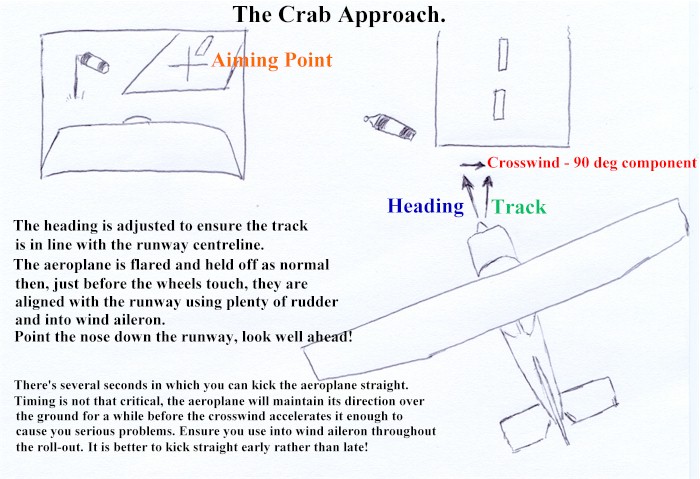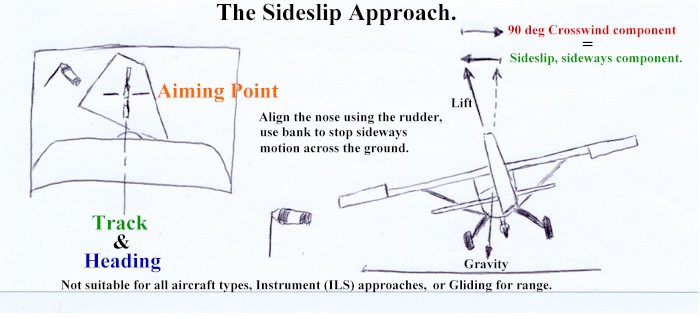
Crosswind Landings.
In the early years aerodromes were big fields with circles in
their centres. Arriving overhead the pilot would look at the
windsock and land directly into the wind keeping the circle on
the left and then turning left to clear the landing area after
landing.
Winter weather would make a lot of these aerodromes soggy and
unserviceable and so someone had the brilliant idea to use
concrete and tarmac as landing surfaces. This stuff is expensive
and so they'd only use a strip of it here and there across the
aerodrome and these were called runways. With the invention of
the runway the crosswind was invented, as was the rotating
tailskid (tailwheel), and brakes had to be fitted to aeroplanes.
The whole thing became more expensive, and in a lot of places
landing fees began to be charged!
Pilots had to learn to cope with the new phenomenon, and trainee pilots suddenly needed ten hours to go solo!
There I was...
Returning to Blackbushe in the Jodel one windy day. The demonstrated 90degree crosswind component for the Jodel 1050 is 8 Knots! The wind was gusty (25G35) between 08 and 13 and so I did an approach for both these runways at the same time while watching the windsock back and veer. On short final I chose 13, flared and kicked it straight (crab method), the wheels contacted the ground smoothly and we rolled to the exit... Turning downwind on the taxyway I had the stick hard back and so suddenly the tail lifted! I immediately stuck the stick forward and the tail dropped back down again without touching the propeller on the ground. The correct deflection of the controls in strong winds is so very important.
Crosswind approach and landing
There are two methods of crosswind approach: Crab and the Wing Low, Side Slip.
Crab.

For this approach we use the same method for drift correction
as we do for each of the legs in the circuit, we point the nose a
little into the wind and maintain wings level. Look for the point
of zero movement in the windscreen (aiming point), this is your
track across the ground.
We maintain this 'crab' until just before the
wheels contact the ground, at this point we must kick off the
drift so that the wheels are aligned with the runway. Look well
ahead and use the rudder to rapidly align the nose with the
runway.
A bit of into wind aileron is useful here much as we would use it
during taxiing with a strong crosswind. This method works for all
aeroplanes, 747’s use it!
Side Slip

In the slipping lesson we learn how to keep the aeroplane
tracking along a road with a crosswind by banking into the wind
and holding direction with the rudder, this is precisely what we
will be doing.
The side slip is maintained throughout the flare and the hold off
and the aeroplane is landed on the into wind main wheel only. To
do this manoeuvre roll the wings into the wind while maintaining
your heading using the rudder until the the drift is observed to
stop. Too much bank and the aeroplane with move into the wind,
too little and you'll drift with the wind. I see most people
using dramatic amounts of bank to combat small breezes; don't do
this, it's not necessary, use as much as is needed and only that
much.
The aeroplane is in a slip, and the slip is used to lose excess
height, so in a power off situation you'll lose height more
rapidly. If you need to do a crosswind landing following an
engine failure I suggest that the crab method is used until
you've made the field.
Really strong, gusting crosswinds...
...can really make your landing approach tough. Be aware of
wind shear, this is where the friction of the surface causes a
reduction in the wind speed as you descend, so maintain a nose
attitude that will ensure that you can maintain control of the
aeroplane; avoid chasing the airspeed indicator.
In this situation I prefer to crab so far as I know I can kick it
straight, and then I sideslip as well. The reduction in wind
speed close to the ground is usually enough for me to remove the
sideslip leaving only the crab. When I learned in England on
Cessna 150's the crab was the preferred method, and the sideslip
was taught as an exercise. In North American the sideslip is
taught first and the crab method is largely ignored... until they
get into the twin and fly an ILS!
Next: Lesson 16.
© Michael Peare 2002